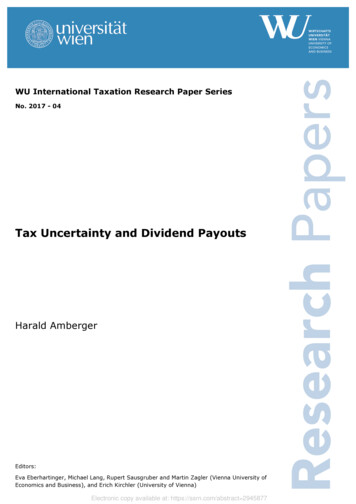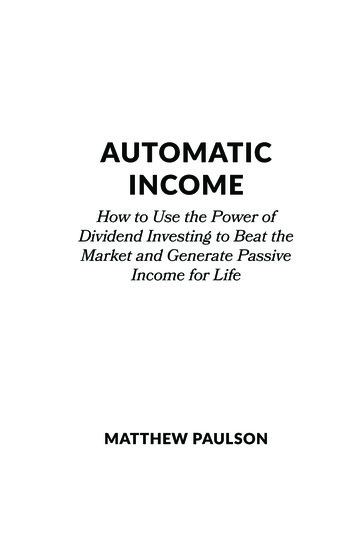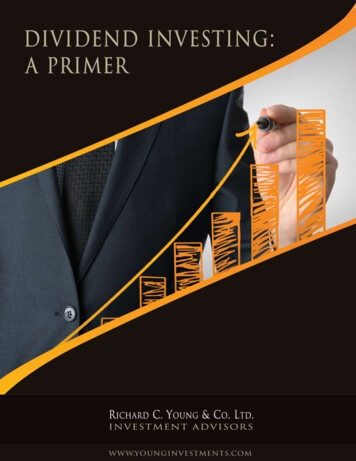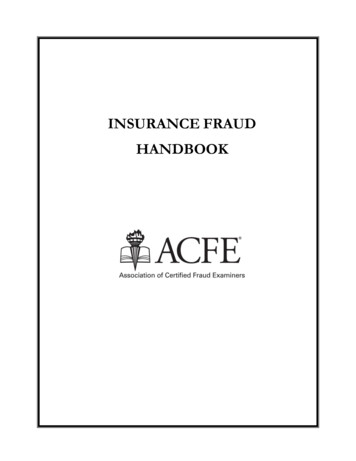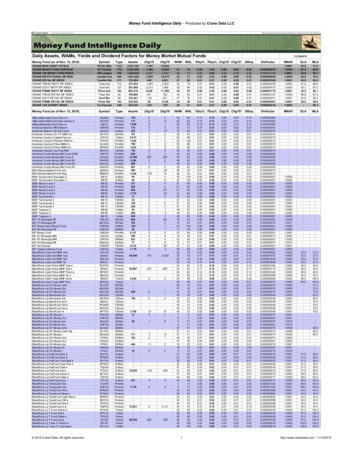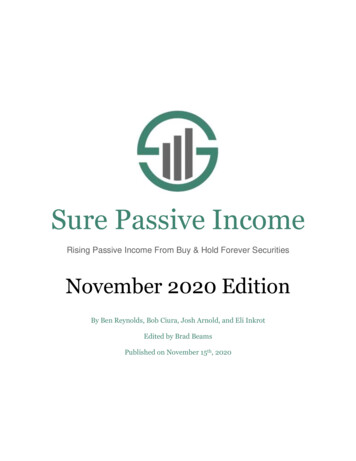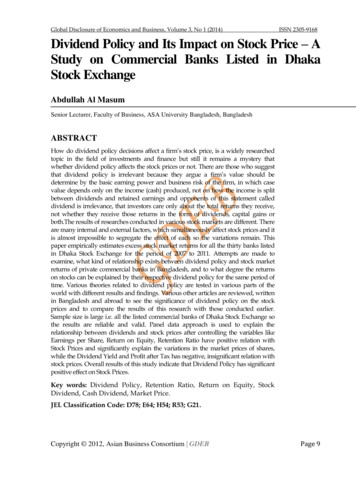
Transcription
Global Disclosure of Economics and Business, Volume 3, No 1 (2014)ISSN 2305-9168Dividend Policy and Its Impact on Stock Price – AStudy on Commercial Banks Listed in DhakaStock ExchangeAbdullah Al MasumSenior Lecturer, Faculty of Business, ASA University Bangladesh, BangladeshABSTRACTHow do dividend policy decisions affect a firm’s stock price, is a widely researchedtopic in the field of investments and finance but still it remains a mystery thatwhether dividend policy affects the stock prices or not. There are those who suggestthat dividend policy is irrelevant because they argue a firm’s value should bedetermine by the basic earning power and business risk of the firm, in which casevalue depends only on the income (cash) produced, not on how the income is splitbetween dividends and retained earnings and opponents of this statement calleddividend is irrelevance, that investors care only about the total returns they receive,not whether they receive those returns in the form of dividends, capital gains orboth.The results of researches conducted in various stock markets are different. Thereare many internal and external factors, which simultaneously affect stock prices and itis almost impossible to segregate the effect of each so the variations remain. Thispaper empirically estimates excess stock market returns for all the thirty banks listedin Dhaka Stock Exchange for the period of 2007 to 2011. Attempts are made toexamine, what kind of relationship exists between dividend policy and stock marketreturns of private commercial banks in Bangladesh, and to what degree the returnson stocks can be explained by their respective dividend policy for the same period oftime. Various theories related to dividend policy are tested in various parts of theworld with different results and findings. Various other articles are reviewed, writtenin Bangladesh and abroad to see the significance of dividend policy on the stockprices and to compare the results of this research with those conducted earlier.Sample size is large i.e. all the listed commercial banks of Dhaka Stock Exchange sothe results are reliable and valid. Panel data approach is used to explain therelationship between dividends and stock prices after controlling the variables likeEarnings per Share, Return on Equity, Retention Ratio have positive relation withStock Prices and significantly explain the variations in the market prices of shares,while the Dividend Yield and Profit after Tax has negative, insignificant relation withstock prices. Overall results of this study indicate that Dividend Policy has significantpositive effect on Stock Prices.Key words: Dividend Policy, Retention Ratio, Return on Equity, StockDividend, Cash Dividend, Market Price.JEL Classification Code: D78; E64; H54; R53; G21.Copyright 2012, Asian Business Consortium GDEBPage 9
Global Disclosure of Economics and Business, Volume 3, No 1 (2014)ISSN 2305-91681. INTRODUCTIONDividend policy is a major financing decision that involves with the payment toshareholders in return of their investments. Every firm operating in a given industryfollows some sort of dividend payment pattern or dividend policy and obviously it is afinancial indicator of the firm. Thus, demand of the firm’s share should to some extent,dependent on the firm’s dividend policy.Dividend policy is one of the most widely researched topics in the field of finance but thequestion is whether dividend policy affects stock prices still remain debatable amongmanagers, policy makers and researchers for many years. Dividend policy is important forinvestors, managers, lenders and for other stakeholders. It is important for investors becauseinvestors consider dividends not only the source of income but also a way to assess the firmsfrom investment points of view. It is the way of assessing whether the company couldgenerate cash or not. Many investors like to watch the dividend yield, which is calculated asthe annual dividend income per share divided by the current share price. The dividend yieldmeasures the amount of income received in proportion to the share price. If a company has alow dividend yield compared to other companies in its sector, it can mean two things: (1) theshare price is high because the market reckons the company has impressive prospects andisn't overly worried about the company's dividend payments, or (2) the company is in troubleand cannot afford to pay reasonable dividends. At the same time, however, a high dividendyield can signal a sick company with a depressed share price. Dividend yield is of littleimportance for growth companies because, retained earnings will be reinvested in expansionopportunities, giving shareholders profits in the form of capital gains.Selecting a suitable dividend policy is an important decision for the bank because flexibilityto invest in future projects depends on the amount of dividends that they pay to theirshareholders. If company pay more dividends then fewer funds available for investment infuture projects. Lenders are also interested in the amount of dividend that a companydeclares, as more amounts is paid as dividend means less amount would be available to thecompany to payoff their obligation. So, the study will investigate the relationship betweendividend policy and its impact on market performance of the share in the Dhaka stockexchange. In this study, researchers will examine with some real life sample (Commercialbanks listed in Dhaka Stock Exchange) that whether the dividend policy has any effect onthe firm’s share price determinants as with compare to many in members other than thedividend payment pattern, researchers just focus on the specific factor; the dividend policy.2. LITERATURE REVIEWGittman (2004, pp. 312) divided stock into two types, such as common stock and preferredstock. He also showed that dividends are the outcome of investment. So, common stocks are anownership claim against primarily real or productive asset (Higgins, 1995), but he also said thatif the company prospers, stockholders are the chief beneficiaries, if it falters, they are the chieflosers. Smith (1988) presented that stocks are one of the most popular forms of investment.People buy stocks for various reasons: some are interested in the long-term growth of theirinvestment by buying low priced stock of a new company in the hope of substantially growthof share price over the next few years. Another reason he suggested that in a well-establishedfirm stockholders expect the stock growth will be stable over the long run. (Smith,1988).Stockholders expect dividend but it is not promised (Gittman, 2004). Common stocks are holdby true owners of the business. Sometimes they are known as ‘residual owners’ as theyCopyright 2012, Asian Business Consortium GDEBPage 10
Global Disclosure of Economics and Business, Volume 3, No 1 (2014)ISSN 2305-9168receive whatever left after winding up of the company (Gittman, 2004; Higgins 1995). Anothertype of stock is known as publicly owned stock. Common stock owned by a broad group ofunrelated investors or institutional investors is called as publicly owned stock. However, allcommon stock of a firm owned by a small group of investors is denoted as closely ownedstock. When all the stock is owned by a single person is known as privately owned stock. Dueto the limit of number of share, stock can be classified in to four types. Such as authorizeshare, outstanding share, treasury stock and issued stock (Gittman, 2004). Authorized sharesrepresent the maximum number of shares a firm allows to issue. Outstanding shares are holdby public. Treasury stock is repurchased by firm itself and it is no longer considered asoutstanding share. Issued shared are the shares that have been put into circulation. Recentlystock repurchase option is very popular as it is able to increase stock value by decreasingoutstanding stock number (Port, 1976). Port also suggested that firms should avoid issuingstock to pay dividend as they slow down company growth.According to Short and Welsch (1990), Johns (1998) and Port (1976), a dividend is a usuallydistributed in cash form to stock holders of a corporation approved by the board of director. Itmay also include stock dividend or other forms of payment. A stock dividend represents adistribution of additional shares to common stockholders (Higgins, 1995).On the other hand,Ross et al. (2005) divided earnings into two parts; either it is retained or paid as dividend.Whereas Wild et al. (2001), Johns (1998) and Kieso et al. (2004) argued that retained earningsare the primary source of dividend distribution to the stockholder. Dividends are only cashpayments regularly made by corporations to their stockholders (Johns, 1998). He alsospecified that they are decided upon the declaration by the board of the directors and canrange from zero to virtually any amount the corporation can afford to pay.Jones (2005) said that dividends are the only cash payment a stockholder receives directlyfrom firm and these are the foundation of valuation for common stocks. Stock price responseto an unexpected dividend change announcement is related to the dividend preferences of themarginal investor in that firm where other things remaining same (Denis et al., 1994). Inaddition, a company, which changes dividend policy, is expected to experience upward ordownward trends in share returns (Gunasekarage et al., 2006). They also said that for theinitiating firms, the share prices continued to rise even after the initial public offering (IPOs).Higgins (1995) said that if the company will have less money to invest, or it will have to raisemore money from external sources to make the same investments stockholders claim onfuture cash flow, which reduces share price appreciation. Moreover, during dividendannouncement period stock price also fluctuate due to announcement of dividend.Mulugettaet al. (2002) examined the impact of Standard and Poor’s ranking changes on stock prices. Inaddition, Affleck-Graves & Mendenhall (1992) found that stock price reacts after 8 days onaverage up to 54 days of such earning announcement.With this believe, Hampton (1996) said that value of stock increase by more dividend andshare remain undervalued by lower dividend policy. In addition, he also showed that thereare two schools of thought regarding with the effect of dividend on stick price, one isdividends do not affect market price and the another one is dividend policies haveprofound effects on a firm’s position in the stock market. . Benartzi et al. (1997), Ofer andSiegel’s (1987) and Bae (1996) found a positive correlation between share price anddividend. Furthermore, Campbell and Shiller (1988) found a relationship between stockprices, earnings and expected dividends and he drives a conclusion that earnings anddividends is powerful in predicting stock returns over several years. Wilkieanalyzed a 76months share price index and dividend announced. He found a correlation coefficient,Copyright 2012, Asian Business Consortium GDEBPage 11
Global Disclosure of Economics and Business, Volume 3, No 1 (2014)ISSN 2305-9168which was under 0.7 for the period 76 months and he also get that the maximum value ofthe regression coefficient being reached after 79 months. Moreover, Shiller (1984, 1989)recommended investors in his study to buy the stocks when price is low relative todividends and to sell stocks when it is high payoffs. On the other hand to their opinion,Jensen and Johnson (1995) suggested that, dividend cut results reduction in share price.More interesting matter is that if capital markets are perfect, dividends have no influenceon the share price (Miller and Modgliani, 1961). Miller and Modgliani (1961) also states thatif the market is imperfect, dividend may affect stock price.3. OBJECTIVES To find the relation between the shares market price and the dividend policy of the banks.To analyze the factors affecting the market price of the banks share.To measure the impact of the bank’s dividend policy on its shares market price.4. DEFINITION OF VARIABLESIn this study market price is taken as dependent variable. Dividend yield, retention ratio,earning per share, return on equity, and net profit after tax are used as independentvariable. It is expected that all these variables have significant effect on stock price.Market Price (MP):Market price is taken as dependent variable which is calculated bytaking the average of high and low market prices of the shares while in the previousstudied researchers like Rashid & Rahman (2009), Nazir, Nawaz, Anwar, & Ahmed(2010), Asghar, Shah, Hamid, & Suleman (2011), Hussainey, K., Mgbame, C.O., &chijoke-Mgbame, A.M. (2011) use price volatility as a dependent variable to see the effectof dividend policy on stock market prices.Dividend Yield (DY): Dividend yield of a stock signifies how much a company paysdividend in relation to its stock price. It is calculated as a fraction of annual dividendspaid by the company upon its stock price. Dividend yield is considered an importantvariable that is used by Allen &Rachim (1996), Nishat and Irfan (2003), Rashid & Rahman(2009), Nazir, Nawaz, Anwar, & Ahmed (2010), Asghar, Shah, Hamid, &Suleman (2011),Hussainey,Mgbame, &Chijoke-Mgbame (2011) and it is significantly explaining the effectof dividend policy on stock market prices. All these researchers found positive relationbetween dividend yield and stock price.Retention Ratio (RR): Retention Ratio is opposite to dividend pay-out ratio and iscalculated by subtracting Total Dividend from Total Earnings and then dividing theresulting amount by Earnings.Pani (2008) used dividend to Retention Ratio to see itseffect on Stock Prices and found positive relation between them. This ratio is previouslyignored by the researchers and they used either dividend payout ratio or dividend yieldratio in their studies for explaining the variation in stock price.Profit after Tax (PAT): Profit after tax is used a control variable. Pani (2008), Adesola &Okwong (2009), Ahmed Javid (2009) and Al-Kuwari (2010) used profit after tax asindependent variable in their studies and found positive relation between stock pricesand profit after tax. They consider profit after tax as an important variable to explain thevariation in stock prices.Earnings Per Share (EPS): Earnings per share is the amount of earnings per eachoutstanding share of a company's stock.Return on Equity (ROE): Return on Equity is calculated by dividing profit after tax withCopyright 2012, Asian Business Consortium GDEBPage 12
Global Disclosure of Economics and Business, Volume 3, No 1 (2014)ISSN 2305-9168shareholders’ equity. Liu & Hu (2005), Raballe&Hedensted (2008) and Ling, Mutalip,Shahrin, &Othman (2008) used Return on Equity in their studies and found positiverelation between Return on Equity and Stock Prices.5. METHODOLOGYThe purpose of this research is to contribute towards a very important aspect of corporatefinancial management known as dividend policy with reference to banking industry,Bangladesh. Here the researchershow the relationship between dividend declaration practiceand its impacts on shares market price of thirtycommercialbanks listed in Dhaka StockExchange (DSE) for the period of five years from 2007 – 2011. The selection of the studyperiod was constrained by the factors, such as its enlistment year in DSE. The researcher onlyconcentrated on the banks that have been listed in DSE on or before 2006 and also subject toavailability of required data. The impact of dividend policy on company performance ofbanking industry is tested by panel data methodology. The panel data methodology use hascertain benefits like using the assumption that the banks are heterogeneous, more variability,less co linearity between variables, more informative data, more degree of freedom and moreefficient. The following section of the article will discuss the banks and variables included inthe study, the distribution patterns of data and applied statistical techniques in investigatingthe relationship between dividend declaration policy and market price of the shares.6. MODEL SPECIFICATIONIn order to find out the relationship between different variables, first Pearson CorrelationCoefficients are calculated. The impact of dividend policy on banksstock’s market price is thaninvestigated using the panel data of selected banks listed in Dhaka Stock Exchange (DSE) underthe banking industry. Researchers develop an empirical framework, first used by Deloof (2003)and subsequently work of Padachi (2006). Our model isMP it ß0 ß1 (DYit) ß2 (RRit) ß3 (PATit) ß4 (EPSit) ß5 (ROEit) ŋt λt ƐitWhere, Dependent Variable Market Price (MP)Independent Variable Dividend Yield (DY), Retained Ratio (RR), Profit After Tax (PAT),Earnings Per Share (EPS),and Return on Equity (ROE).Here, MP is Market Price is used as ameasure of bank’s market performance. It is expected that Dividend Yield, Dividend per Share,Return on Equity, Return on Assets and Earning per Share will be positively associated to stockmarket prices i.e. increases in dividend, earning per share, return on equity, return on assets willresult in increasing the stock market price of the banks while retention ratio and retainedearningsper share has negative effect on stock price.ŋt measures the specific characteristics of eachbank called unobservable heterogeneity, whereas λt is a parameter for time dummy variableswhich is equal for all banks in each year but changes over time and Ɛ is the error term.7. FINDINGSThe results of the impact of dividend policy and other explanatory variables on stock pricearepresented in the following section. First, the descriptive analysis is presented followed by thePerason’s correlation analysis to see the association between stock price and all independentvariables. Panel data analysis with fixed effect and random effect modelsare also used in order to seethe impact of dividend policy on the market price of the listed commercial banks in DSE.Copyright 2012, Asian Business Consortium GDEBPage 13
Global Disclosure of Economics and Business, Volume 3, No 1 (2014)ISSN 2305-91687.1 Descriptive StatisticsTable 1 shows the detail of descriptive statistics of variables that affect the Market Price of thePrivate Commercial Banks listed in DSE for the period of 2007 to 2011. Market Price which isthe dependent variable in the model ranges from 12.55 to 6129.70 with a mean value of780.359 and standard deviation is 980.2878. The first explanatory variable is dividend yieldwith a mean value of 0.04309 and a standard deviation of 0.033976. Retention ratio which isthe second explanatory variable ranges from 0 to 1.775 and its mean value and standarddeviation is 0.598373 and 0.258545 respectively. Profit after tax which is the third explanatoryvariable has a minimum value Tk. -11017.5 million and maximum value Tk. 11185.86 millionwith mean 1293.129 and standard deviation2164.601. The fourth explanatory variable isEarnings per Share with a mean value of 32.007and a standard deviation of 130.4542. Finally,The fifth explanatory variableReturn on Equity shows the minimum value -0.298 andmaximum value 1.04 with mean 0.19588and standard deviation 0.112727.Table1: Descriptive StatisticsMarket PriceDividend YieldRetention RatioProfit After TaxEarnings Per ShareReturn on EquityKurtosisSkewnessStd.Deviation Statistic Std. Error Statistic Std. ErrorMaximumMean12.556129.7780.359980.2878 3.0791070.2000010.93520.3974500.1340.043090.033976 .129 007130.4542 2727 2.1927630.1980322.82530.39358Source: Primary7.2 Correlation Analysis:Correlation matrix of all variables included in the analysis is presented in table 2 which iscalculated based on data of 150 observations. The table shows that stock price is negativelyassociated with profit after tax, dividend yield and retention ratio, and stock price is positivelyassociated with return on equity and earning per share. The correlation coefficients fordividend yield and retention ratio are significant.Table2: Pearson Correlation Coefficient between variables of 30 private commercial banks (150observations)MPPATEPSPearson Correlation1Sig. (2-tailed).1PAT Pearson Correlation -.123Sig. (2-tailed).137.0541EPS Pearson Correlation .128Sig. (2-tailed).123.514.DY Pearson Correlation -.246(**) .180(*) .065Sig. (2-tailed).003.029.435RR Pearson Correlation -.183(*) .306(**) -.188(*)Sig. (2-tailed).026.000.021-.121 -.507(**)ROE Pearson Correlation .140Sig. 010.9031.** Correlation is significant at the 0.01 level (2-tailed).Copyright 2012, Asian Business Consortium GDEBPage 14
Global Disclosure of Economics and Business, Volume 3, No 1 (2014)ISSN 2305-9168* Correlation is significant at the 0.05 level (2-tailed).;Source: PrimaryData reflects significant correlations betweendividend yield and profitafter tax, retentionratio and profit after tax,retention ratio andearning per share,return on equity and earningper share. The correlation betweenearning per shareand profit after tax is (.054), dividendyield and profit after tax is (.180), dividend yield and earning per share is (.065), retentionratio and profit after tax is (.306), retention ratio andearning per share is (-.188), and returnon equity and earning per share is (-.507). This has been taken into consideration in theregression analysis to avoid multi-colinearity problem.7.3 Empirical Model:Impact of dividend policy onstock price oftheCommercial Banksin Bangladesh is estimatedusing panel data analysis. Fixed Effect and Random Effect Model are used to validate theresults after including the two independent variables Dividend Yield and Retention Ratio andcontrol variables Profit after Tax, Earnings per Share, and Return on Equity. Table 3 exhibitedthe results of Fixed Effect Model and Table 4 exhibited the results of Random Effect Model.Table 3: Fixed Effect Model:VariablesconstantReturn on equityRetention RatioDividend YieldEarnings Per ShareProfit After .22544Std. 5t2.033.270.01-2.904.67-5.07P t0.0450.0010.9900.0050.0000.000[95% Conf. Interval]14.93839 1242.7361166.537 4748.509-648.8447 657.0074-10501.84 -1968.4413.282266 8.127712-.3135182 -.1373546Effect SpecificationF statistics 8.72Prob F 0.0000R-squared 0.6428Adjusted R-squared 0.5344Source: PrimaryFixed Effect Model provides statistically better results than Random Effect Model.Dividend Yield is negatively related to Stock Price and the impact is significant in both theFixed Effect and Random Effect Model. On the other hand, Retention Ratio is positivelyrelated to Stock Price in Fixed Effect Model but negatively related to Stock Price inRandom Effect Model and the impact is insignificant in both of the models. The relationbetween Dividend YieldandStock Price is similar to Baskin (1989) but contrast to theresults of Khan, K. I., et. al. (2011), and Nazir, Nawaz, Anwar, & Ahmed (2010).Negativerelation between Retention Ratioand Stock Price shows the shareholders want their banksto pay dividends and when the banks retain that amount to fulfill their internal needs; thiswill negatively affect the stock prices.Two control variables Earnings per Share and Return on Equity are positively related to StockPrice, but Profit after Tax is negatively related to Stock Price in case of both Fixed Effect andRandom Effect Models. The impact of Earning per Share on Stock Price is highly significantand the result is consistent with K. I., et. al. (2011) and Adesola & Okwong (2009) who alsofound significant relation with Stock Price. The significant negative relation between Profitafter Tax and Stock Price indicates that the share holders are not concerned with the profit ofCopyright 2012, Asian Business Consortium GDEBPage 15
Global Disclosure of Economics and Business, Volume 3, No 1 (2014)ISSN 2305-9168the banks; they are only concerned with the amount of dividend paid to them. On the otherhand, significant positive relation between Return on Equity and Stock Price shows that whenmanagement efficiently utilizes the shareholders’ funds and provides better return oninvestment, it will positively affect the Stock Prices.K. I., et. al. (2011) and Raballe & Hedensted(2008) also found positive relation between Return on Equity and Stock Prices.Table 4: Random Effect Model:MPConstantCoef.517.949Std. Err.272.2738t1.90P t0.057Return on equity3673.651800.45784.590.000[95% Conf. Interval]-15.69782 1051.5962104.782 5242.519Retention Ratio-32.52537295.8994-0.110.912-612.4774Dividend Yield-8397.2622086.978-4.020.000-12487.66 -4306.861Earnings Per Share6.259431.115965.610.0004.072189Profit After Tax-.1752699.0417759-4.200.000-.2571492 -.0933907547.42678.446671Effect SpecificationF statistics Prob F13.32 0.0000R-squared 0.6348Adjusted R-squared 0.5244Source: Primary8. CONCLUSIONIn the last decade stock market of Bangladesh went through many changes and huge upsand downs were seen. The economic crisis of the world in year 2009-11 also affected themarket adversely. In the last couple of years the markets have again try to shown steadyupward trend. All these fluctuations in the stock prices due to external factors, includinginternational factors, make it difficult to check the impact of dividend policy. Here it is alsopertinent to mention that stock markets of Bangladesh are mainly speculative and capitalgains are mostly sought by investors, particularly individual investors. Institutions andlong term investors give due consideration to dividends and dividend polices ofcompanies, which is a large and significant portion of the total investment in the stockmarkets.The objective of the study was to analyse the relationship between Dividend Policy& Stock Price of thirty commercial banks of Bangladesh listed in Dhaka Stock Exchangefrom 2007 to 2011. The empirical estimation based on the Fixed Effect and Random EffectModel show significant negative relation between Dividend Yield and Stock Price whileRetention Ratio has a negative but statistically insignificant relationship with Stock MarketPrices. This paper further shows that Return on Equity and Earnings per share havestatistically significant positive impact on stock price and Profit after Tax has a significantnegative impact on Stock Market Prices of the commercial banks of Bangladesh.REFERENCES[1] Almeyda, G 1996, Money matters: reaching women microentrepreneurs with financialservices, Inter-American Development bank/ UNIFEM.[2] Besley, S & Brigham, EF 2008, Essentials of managerial finance, The Dryden Press, Orlando.Copyright 2012, Asian Business Consortium GDEBPage 16
Global Disclosure of Economics and Business, Volume 3, No 1 (2014)ISSN 2305-9168[3] Chowdhury, TA & Ahmed, K 2009, „Performance evaluation of selected private commercialbanks in Bangladesh‟, International Journal of Business and Management, vol. 4, no. 4, pp. 86-97.[4] Dong, M., Robinson, C., & Veld, C. (2005). Why Individual Investors Want Dividends.Journal of Corporate Finance, 1 (12), 121-158.[5] Gitman and Chad J. Zutter (Dec 7, 2011),”Principles of Managerial Finance,[6]Gorden, M. J. (1963). Optimal Investment and Financing Policy. The Journal of Finance, 18 (2), 264-272.[7] Higgins, 1995, „Dividend changes and future profitability‟, The Journal of Finance, vol. 56, no. 6,pp. 2111-33.[8] Nishat, M., &Irfan, C. M. (2003).Dividend Policy and Stock Price Volatility in Pakistan.11thPacific Basin Finance, Economics and Accounting Conference.[9] Ogden, JP 1994, „A dividend payment effect in stock returns‟, The Financial Review, vol.29, no. 3, pp. 345-69.[10] Rankine, GW &Stice, EK 1997, „Accounting rules and the signalling properties of 20percent stock dividends‟, The Accounting Review, vol. 72, no. 1, pp. 23-46.[11] Smith,1988, „Dividend policy, growth, and the valuation of shares‟, The Journal ofBusiness, vol. 34, no. 4, pp. 411-33.[12] The Dhaka Stock Exchange 2013, viewed 25 march 2013, http://www.dsebd.org .[13] Woolridge, JR 1983, „Dividend changes and security prices‟, The Journal of Finance, vol. 38, no. 5,pp. 1607-15.[14] World Bank 1996, Implementing the World Bank’s gender policies, progress report no. 1,World Bank, Washington, DC.[15] Yilmaz, AK &Gulay, G 2006, „Dividend policies and price-volume reactions to cash dividendson the stock market: evidence from the Istanbul Stock Exchange‟, Emerging Markets Financeand Trade, vol. 42, no. 4, pp. 19-49.[16] Khan, K. I., Amir, M., Qayyum, A., Nasir, A., & Khan, M.I. (2011). Can dividend decisions affectthe stock prices: A case of dividend paying companies of KSE.International Research Journal ofFinance and Economics, Volume 76(2011), pp. 67-74.Why Open Access ?“In the traditional publishing model, readers have limited access to scientific papers; authors do not havecopyright for their own papers, and cannot post their papers on their own websites, which presents asignificant barrier to the sharing of knowledge, as well as being unfair to authors. Open access canovercome the drawbacks of the traditional publishing model and help scholars build on the findings oftheir colleagues without restriction”Submit your next manuscript at- www.abcjournals.netABC Journals is a unique forum to offer open access to all of its articles.Now ABC Journal’s portfolio is over nine journals, which publish both online and in print.Copyright 2012, Asian Business Consortium GDEBPage 17
Global Disclosure of Economics and Business, Volume 3, No 1 (2014)ISSN 2305-9168Global Disclosure of Economics and Business(Peer reviewed international journal)Open Access Philosophy1.2.3.Under Open Access Philosophy,GDEB will not charge for t
on the share price (Miller and Modgliani, 1961). Miller and Modgliani (1961) also states that if the market is imperfect, dividend may affect stock price. 3. OBJECTIVES To find the relation between the shares market price and the dividend policy of the banks. To analyze the factors affecting the market price of the banks share.
